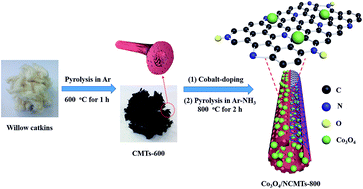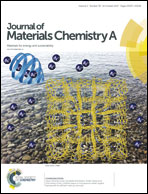Biomass willow catkin-derived Co3O4/N-doped hollow hierarchical porous carbon microtubes as an effective tri-functional electrocatalyst†
Abstract
Oxygen reduction (ORR), oxygen evolution (OER), and hydrogen evolution (HER) reactions are extremely important electrochemical reactions for electrochemical energy conversion and storage. The development of highly efficient, low-cost, durable, and sustainable electrocatalysts is required for these three crucial electrochemical reactions. Herein, an effective tri-functional electrocatalyst, Co3O4 nanoparticle-modified N-doped hollow hierarchical porous carbon microtubes (Co3O4/NCMTs), was successfully prepared via the pyrolysis of metal cobalt(II) complex willow catkin biomass under an argon–ammonia atmosphere. The obtained carbon materials inherit the original micron tubular structure of the willow catkin and form a hollow micro/mesoporous hierarchical construction. Ammonia can hugely elevate the content of doped nitrogen in the carbon skeleton. The doped N and Co3O4 nanoparticles contribute to form more active sites for the electrochemical reactions. When compared with the Pt/C catalyst, the Co3O4/NCMT-800 electrocatalyst with a positive onset potential (E0 = 0.906 V) and half-wave potential (E1/2 = 0.778 V) exhibit superior catalytic stability and tolerance to methanol in the ORR. The optimal Co3O4/NCMT-800 material exhibit high activity with a low overpotential of 0.35 V for the OER and 0.21 V for the HER to achieve a current density of 10 mA cm−2. The enhanced OER and HER performance of the Co3O4/NCMTs contribute to improve the overall water splitting ability. The excellent tri-functional electrocatalytic activity can be ascribed to the doped N and Co3O4 nanoparticles loaded into the hollow hierarchical porous carbon microtubes that accelerate electron transport and enhance charge delocalization. Due to the abundant biomass precursor with a unique structure, the advanced non-noble metal-doped hollow porous carbon materials exhibit outstanding application prospects in the electrocatalysis field.



 Please wait while we load your content...
Please wait while we load your content...